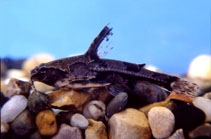| Family: |
Doradidae (Thorny catfishes), subfamily: Doradinae |
| Max. size: |
15 cm TL (male/unsexed) |
| Environment: |
demersal; freshwater; pH range: 6 - 8; dH range: 5 - 19 |
| Distribution: |
South America: Guyana and eastern Brazil to Peru and Bolivia. |
| Diagnosis: |
Dorsal spines (total): 1-1; Dorsal soft rays (total): 6-6; Anal soft rays: 11-13. The body is a little elongated, without scales but with a lateral range of 24 to 28 bony plaque. Head is large and rounded. Mouth is nearly terminal and has three pairs of barbels (Ref. 35381). |
| Biology: |
Occurs in freshwater coastal swamps and the flood-prone zones of rivers. Gregarious, lives schools which may consist of several hundred fish. Hides under roots, leaves or stocks. Is known to build a nest of bubbles at the surface, defended by the males as the 'Atipas' do. In case of drought, it is reputed to being very resistant and to crawl in search of a new swamp while holding some water in its ears. Feeds on algae and debris (Ref. 35381). |
| IUCN Red List Status: |
Least Concern (LC); Date assessed: 05 August 2020 Ref. (130435)
|
| Threat to humans: |
harmless |
Source and more info: www.fishbase.org. For personal, classroom, and other internal use only. Not for publication.

